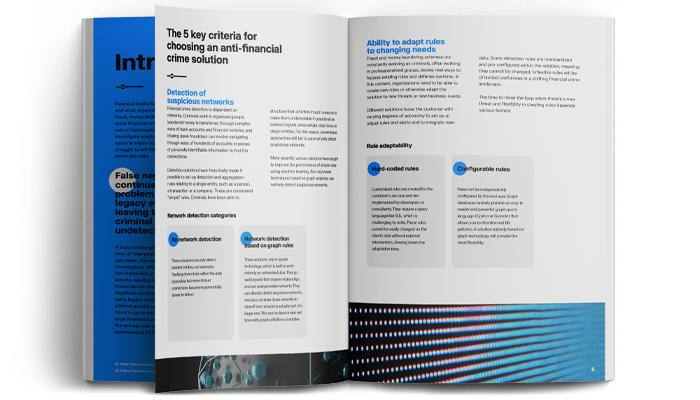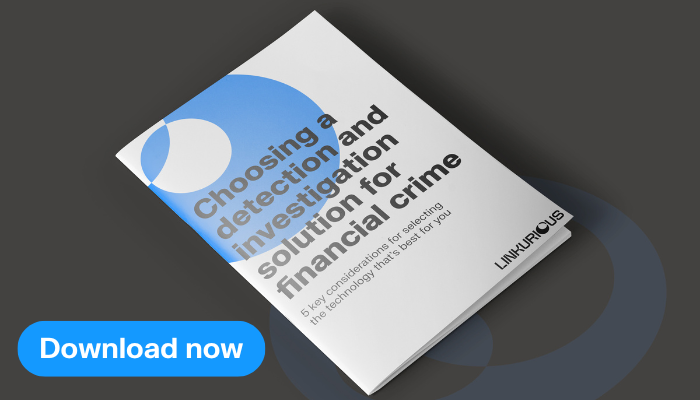How to choose a detection and investigation solution for financial crime
Financial institutions, governmental agencies and other organizations working to counter fraud, money laundering, corruption, and other financial crime depend on large sets of heterogeneous data to detect and investigate suspicious activity. The legacy systems many organizations still use often struggle to efficiently pinpoint anomalies within the data.
A major challenge that has emerged is a high level of false positives - up to 95% (1) in AML use cases. The result is that most of investigators’ efforts end up concentrated on non-fraudulent or otherwise non-criminal activity, wasting human and financial resources.
On the other hand, false negatives continue to be a problem when using legacy systems, leaving too much criminal activity undetected. In the case of fraud in particular, this can result in very large financial losses: according to the ACFE, the average loss per fraud against businesses is $1.78 million (2).
The right financial crime detection and investigation solution has an important role to play in managing these challenges and helping analysts more efficiently tackle criminal activity.
Our recent white paper explores in detail the key characteristics of efficient detection and investigation solutions for financial crime. Broken down into several criteria and specific points of comparison, this resource aims to help you out by examining the capabilities, strengths, and weaknesses of different types of anti-financial crime solutions.
Whether you’re looking to add network analysis capabilities to your existing stack, or want to roll out a full new financial crime detection and investigation solution, our guide can help you more clearly navigate the technology landscape and help you identify which tools are best suited to your needs.
With a large market offer that includes emerging technologies, our guide helps you sort through it all by looking at the main points of consideration and comparison. What criteria should you use to decide if certain technologies or product features meet your team’s needs? What questions should you be asking about your tech stack as you decide what to add or replace?
We cover five key categories that can help you evaluate the performance of a given detection and investigation solution:
Detection solutions have historically made it possible to set up detection and aggregation rules relating to a single entity, such as a person, a transaction or a company. But conventional approaches fail to automatically detect suspicious networks. Newer approaches offer varying degrees of network detection capabilities.
Historically, investigation solutions - based on tabular interfaces - have provided limited tools for data exploration. But the ability for analysts to effectively explore their data and make faster decisions depends largely on how the solution performs on link analysis. We look at how this performance differs across different types of investigation solutions.
In the context of evolving criminal schemes, organizations need to be able to create new rules or otherwise adapt the solution to new threats or new business needs. Different solutions leave the customer with varying degrees of autonomy to set up or adjust rules and alerts and to integrate new data.
Financial institutions and other organizations use multiple sources for detection and investigation. Compliance regulations around politically exposed persons or sanctioned entities require specialized solutions like sanctions lists or compliance databases, for example. Integration capabilities are therefore paramount both for cost management and to effectively counter financial crime.
As compliance rules tighten and financial crime threats become more complex, the resources organizations invest in anti-financial crime solutions have tended to increase. An important consideration for any piece of your tech stack is the global cost of ownership. What key questions should you be asking yourself?
The market offer for detection and investigation solutions is only growing, and sorting through the large offer can feel daunting. Discover how to compare today’s solutions on the basis of these five essential criteria.
(1) https://www.reuters.com/article/bc-finreg-laundering-detecting-idUSKCN1GP2NV
(2) https://www.acfe.com/about-the-acfe/newsroom-for-media/press-releases/press-release-detail?s=2022-RTTN-launch
A spotlight on graph technology directly in your inbox.

